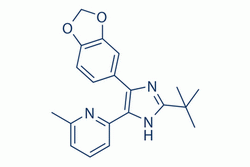| Cas No.: | 694433-59-5 |
| Chemical Name: | SB505124 |
| Synonyms: | SB 505124; SB505124 |
| SMILES: | C(C1NC(C(C)(C)C)=NC=1C1C=C2C(=CC=1)OCO2)1=NC(C)=CC=C1 |
| Formula: | C20H21N3O2 |
| M.Wt: | 335.4 |
| Sotrage: | 2 years -20°C Powder, 2 weeks 4°C in DMSO, 6 months -80°C in DMSO |
| Description: | SB-505124 is a selective inhibitor of TGFβR with IC50 of 129 nM and 47 nM for ALK4, ALK5, respectively, and it does not inhibits ALK1, 2, 3, or 6 but ALK7. |
| In Vitro: | SB-505124 demonstrates no toxicity to renal epithelial A498 cells at concentrations up to 100 μM for 48 h. 505124 inhibits the closely related ALK4 with an IC50 value of 129±11 nM (about 2.5-fold less sensitive than ALK5) but does not inhibit ALK2 at concentrations up to 10 μM. SB-505124 (1 μM) inhibits the TGF-β-induced phosphorylation of Smad2 in all three of these cell lines in a concentration-dependent fashion. SB-505124 (1 or 5 μM) potently inhibits TGF-β-induced activation of JNK/SAP, extracellular signal-regulated kinase 1/2, and p38 despite the different patterns of activation in these cells[1]. SB-505124 (10 µM) impairs Smad2 phosphorylation and CTGF and α-SMA expression in vitro[2]. SB-505124 susspresses CTGF and α-SMA observed by immunofluorescence. Cell outgrowth from explants dissected from eyes to which SB-505124 is applied during GFS is robust while outgrowth is poor from those treated with MMC[3]. |

 DC Chemicals' products qualify for U.S. tariff exemptions. We guarantee no price increases due to customs duties and maintain stable supply, continuing to deliver reliable research solutions to our American clients.
DC Chemicals' products qualify for U.S. tariff exemptions. We guarantee no price increases due to customs duties and maintain stable supply, continuing to deliver reliable research solutions to our American clients.





















